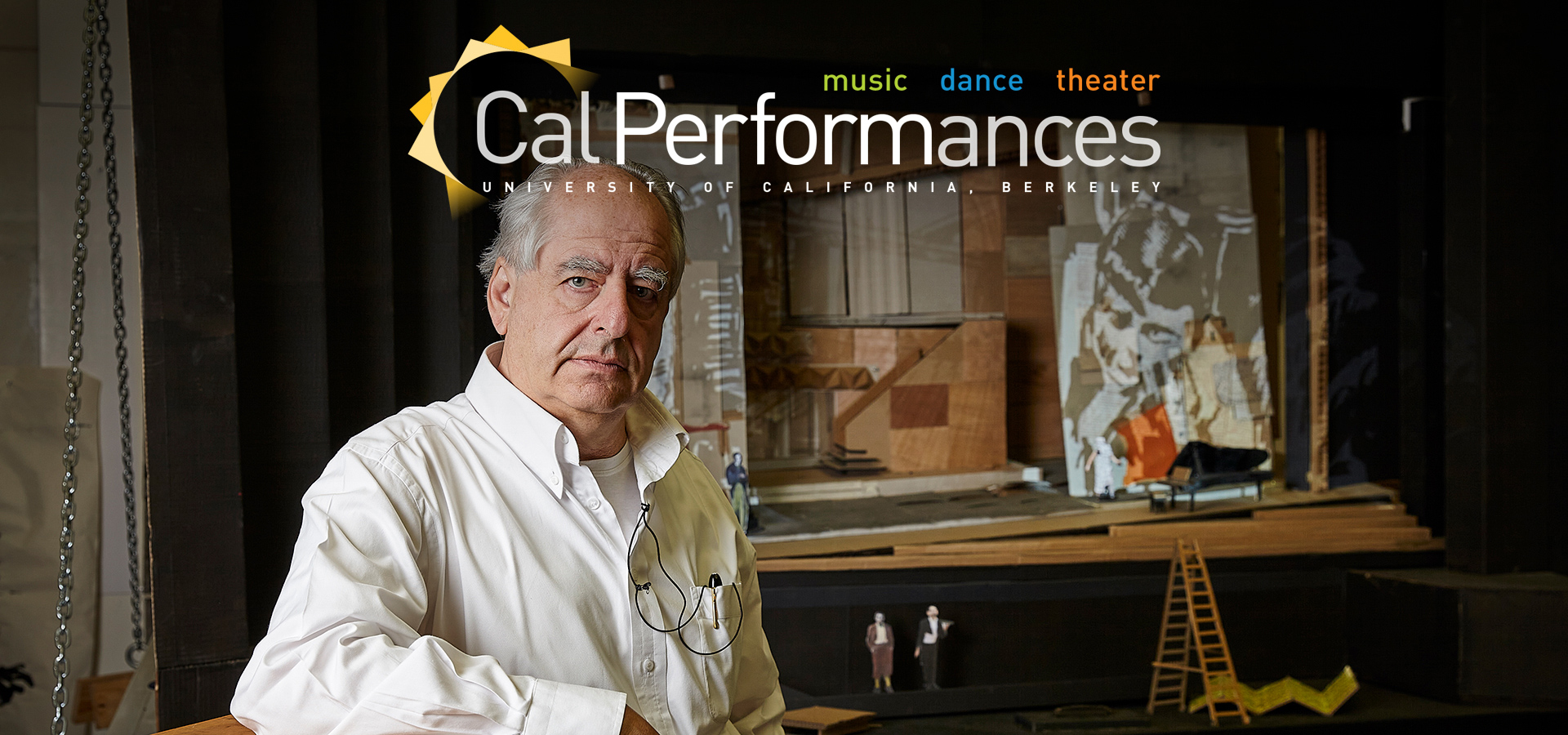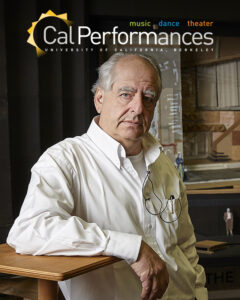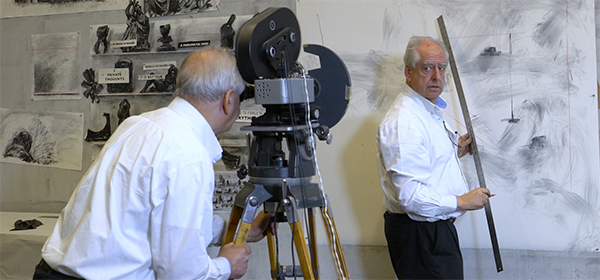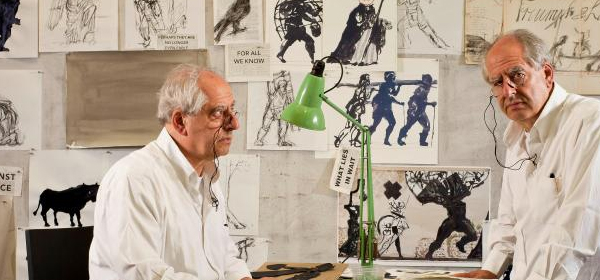William Kentridge Residency
University of California, Berkeley 2022–23
Ursonate
Friday, March 10, 2023, 8pm
Zellerbach Playhouse
Run time for Ursonate is approximately 1 hour with no intermission.
A Guided Tour of the Exhibition: For Soprano and Handbag
Wednesday, March 15, 2023, 7:30pm
Zellerbach Playhouse
Run time for A Guided Tour of the Exhibition is approximately 50 minutes with no intermission.
William Kentridge’s SIBYL
Friday, March 17, 2023, 7pm
Saturday, March 18, 2023, 8pm
Sunday, March 19, 2023, 3pm
Zellerbach Hall
Run time for SIBYL is approximately 85 minutes, including intermission.
From the Executive and Artistic Director
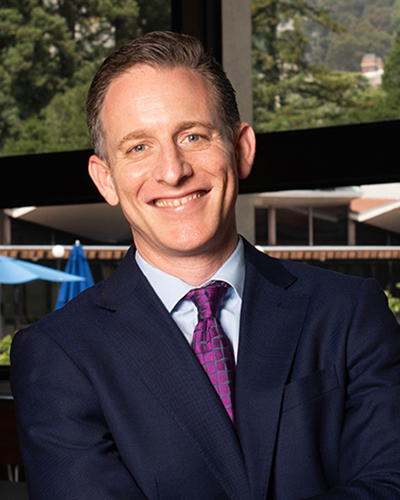
It would be hard to exaggerate the depth and breadth of Cal Performances’ programming this month, a schedule distinguished by the culmination of our season-long, campus-wide residency honoring the visionary work of South African artist William Kentridge—the man the UK’s Guardian described as “continuously original, deeply humane, and vividly thought-provoking…one of the great artists of our time.” Residency events include the US premiere of Kentridge’s musical and theatrical work SIBYL at Zellerbach Hall (for more, see Thomas May’s excellent article, beginning on the next page), including a special gala honoring the artist; a presentation of the Dadaist poem Ursonate, performed by Kentridge himself; a staging of A Guided Tour of the Exhibition: For Soprano and Handbag, a bold and innovative work created by Kentridge and Joanna Dudley (who will also perform it); a retrospective of Kentridge’s films; the visual lecture To What End; and classroom conversations. We’re thrilled to play a major role in this extraordinary artistic endeavor and thank our partners—the Berkeley Art Museum and Pacific Film Archive (BAMPFA) and the Townsend Center for the Humanities—for their contributions to this great celebration.
During any other month, the Kentridge Residency would be more than enough to trumpet. But March at Cal Performances will also see a return engagement by the storied Vienna Philharmonic Orchestra, under conductor Christian Thielemann (making his Bay Area concert debut). Over the course of three programs at Zellerbach Hall, the orchestra will traverse a century of canonic repertoire—from the heroic music of Viennese classicism, through several generations of opulent Austro-German Romanticism, to the expanded sonorities of the Second Viennese School near the turn of the 20th century. These works showcase the mighty Vienna musicians at their finest, artists renowned for playing both “rich in detail and fearsome in its intensity” (The Guardian).
If all of this weren’t enough, we’ll also see a long-anticipated visit by New Orleans’ legendary Preservation Hall Jazz Band celebrating its 60th anniversary this year with a rousing program of traditional jazz, gutbucket funk, Afro-Cuban rhythms, folk, and pop; and a performance of Handel’s great oratorio Solomon (1748) with the renowned English Concert, the Clarion Choir, and an impressive array of guest vocalists. Our great friend Zakir Hussain returns with his ever-popular Masters of Percussion; the London-based Castalian Quartet makes its Cal Performances debut with a program that ranges from Haydn to Schubert to a haunting 2006 work by contemporary Finnish composer Kaija Saariaho; and we’ll cap off the month with concerts by the international all-woman jazz supergroup Artemis and the accomplished Zurich Chamber Orchestra with music director and violinist Daniel Hope.
Upcoming Illuminations: “Human and Machine” programming (much of it presented in conjunction with the Kentridge Residency) will continue to take advantage of Cal Performances’ unique positioning as a vital part of the world’s top-ranked public university. As we’ve done all
season long, we’ll be engaging communities on and off campus to examine the evolution of tools such as musical instruments and electronics, the complex relationships between the creators and users of technology, the possibilities enabled by technology’s impact on the creative process, and questions raised by the growing role of artificial intelligence in our society.
Please make sure to check out our brochures and our website for complete information about upcoming events. And stay tuned in April, when we announce our 2023–24 season; we’ve got plenty of exciting news for you.
Thank you for joining us at Cal Performances!
Jeremy Geffen
Executive and Artistic Director, Cal Performances
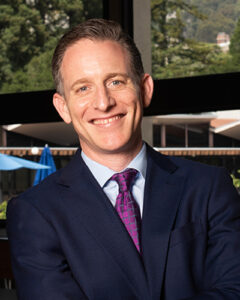 It would be hard to exaggerate the depth and breadth of Cal Performances’ programming this month, a schedule distinguished by the culmination of our season-long, campus-wide residency honoring the visionary work of South African artist William Kentridge—the man the UK’s Guardian described as “continuously original, deeply humane, and vividly thought-provoking…one of the great artists of our time.” Residency events include the US premiere of Kentridge’s musical and theatrical work SIBYL at Zellerbach Hall (for more, see Thomas May’s excellent article, beginning on the next page), including a special gala honoring the artist; a presentation of the Dadaist poem Ursonate, performed by Kentridge himself; a staging of A Guided Tour of the Exhibition: For Soprano and Handbag, a bold and innovative work created by Kentridge and Joanna Dudley (who will also perform it); a retrospective of Kentridge’s films; the visual lecture To What End; and classroom conversations. We’re thrilled to play a major role in this extraordinary artistic endeavor and thank our partners—the Berkeley Art Museum and Pacific Film Archive (BAMPFA) and the Townsend Center for the Humanities—for their contributions to this great celebration.
It would be hard to exaggerate the depth and breadth of Cal Performances’ programming this month, a schedule distinguished by the culmination of our season-long, campus-wide residency honoring the visionary work of South African artist William Kentridge—the man the UK’s Guardian described as “continuously original, deeply humane, and vividly thought-provoking…one of the great artists of our time.” Residency events include the US premiere of Kentridge’s musical and theatrical work SIBYL at Zellerbach Hall (for more, see Thomas May’s excellent article, beginning on the next page), including a special gala honoring the artist; a presentation of the Dadaist poem Ursonate, performed by Kentridge himself; a staging of A Guided Tour of the Exhibition: For Soprano and Handbag, a bold and innovative work created by Kentridge and Joanna Dudley (who will also perform it); a retrospective of Kentridge’s films; the visual lecture To What End; and classroom conversations. We’re thrilled to play a major role in this extraordinary artistic endeavor and thank our partners—the Berkeley Art Museum and Pacific Film Archive (BAMPFA) and the Townsend Center for the Humanities—for their contributions to this great celebration.
During any other month, the Kentridge Residency would be more than enough to trumpet. But March at Cal Performances will also see a return engagement by the storied Vienna Philharmonic Orchestra, under conductor Christian Thielemann (making his Bay Area concert debut). Over the course of three programs at Zellerbach Hall, the orchestra will traverse a century of canonic repertoire—from the heroic music of Viennese classicism, through several generations of opulent Austro-German Romanticism, to the expanded sonorities of the Second Viennese School near the turn of the 20th century. These works showcase the mighty Vienna musicians at their finest, artists renowned for playing both “rich in detail and fearsome in its intensity” (The Guardian).
If all of this weren’t enough, we’ll also see a long-anticipated visit by New Orleans’ legendary Preservation Hall Jazz Band celebrating its 60th anniversary this year with a rousing program of traditional jazz, gutbucket funk, Afro-Cuban rhythms, folk, and pop; and a performance of Handel’s great oratorio Solomon (1748) with the renowned English Concert, the Clarion Choir, and an impressive array of guest vocalists. Our great friend Zakir Hussain returns with his ever-popular Masters of Percussion; the London-based Castalian Quartet makes its Cal Performances debut with a program that ranges from Haydn to Schubert to a haunting 2006 work by contemporary Finnish composer Kaija Saariaho; and we’ll cap off the month with concerts by the international all-woman jazz supergroup Artemis and the accomplished Zurich Chamber Orchestra with music director and violinist Daniel Hope.
Upcoming Illuminations: “Human and Machine” programming (much of it presented in conjunction with the Kentridge Residency) will continue to take advantage of Cal Performances’ unique positioning as a vital part of the world’s top-ranked public university. As we’ve done all
season long, we’ll be engaging communities on and off campus to examine the evolution of tools such as musical instruments and electronics, the complex relationships between the creators and users of technology, the possibilities enabled by technology’s impact on the creative process, and questions raised by the growing role of artificial intelligence in our society.
Please make sure to check out our brochures and our website for complete information about upcoming events. And stay tuned in April, when we announce our 2023–24 season; we’ve got plenty of exciting news for you.
Thank you for joining us at Cal Performances!
Jeremy Geffen
Executive and Artistic Director, Cal Performances
Ursonate
Making use of Kurt Schwitters’ original “Ursonate,” William Kentridge’s adaptation is part performance, part lecture, and part symphony. Watching the Ursonate, however, can also make it seem as if it is none of these things.
On a raised platform backed by a full-scale projection, Kentridge takes his position at a makeshift podium. He opens a book and on the projection behind him, a book opens as well. This is perhaps the last time the performance takes the shape of a conventional lecture. From the opening line of the piece: “Fumms bö wö tää zää Uu, pögiff, kwii Ee,” the Ursonate launches into a symphony of audio-visual performance.
Kentridge, who addresses the audience in varying phrases throughout, is backed by stop-motion visual works of his own making, some echoing the words and phrases he is uttering, and others filling in for the gaps in our understanding. On a screen behind Kentridge, projected images of pages of text spin by furiously, rich with his trademark charcoal-drawn characters, including birds, horses, and human figures: soldiers proud and defeated, a rotund German general from World War I, and Kentridge himself.
There are text-based pieces flickering on and off screen, renderings of loudhailers morphing into still-life works, and dancers performing improvisational pieces of movement on loop. Kentridge’s own tool, his voice, adopts different tones and pitches throughout, and it is through this combination of seemingly random words and images that the lecture begins to make sense. Gibberish becomes impassioned debate while body language—the slight wag of a finger or the outward extension of the palms—helps form a compelling argument.
Ultimately, the Ursonate builds up to a frenzy before reaching the cadenza—a magnificent collapse of rhyme and reason. More polished than any vintage Dada performance, and richer in freely accessible humor, Kentridge’s Ursonate nonetheless pays homage to its predecessors by demonstrating how helpful the language of absurdism can still be in addressing a world that makes no sense. Amidst the noise, the chaos, and the explosions, conclusions are reached, or abandoned, before being revived anew.
The Ursonate is chaotic, but it also finds a place in the everyday. You could find versions of its form in a speech by a politician, or a talk by an academic. And while its contents may be left very much up to interpretation, the Ursonate’s universality boils down to those very basic forms of communication, like the slight wag of a finger or the outward extension of the palms.
A Guided Tour of the Exhibition: For Soprano and Handbag
Guided tours in museums intend to give visitors a closer understanding of the artworks on exhibit. On the other hand, every text explaining a work of art automatically places it in the past, immobilizing and silencing it. This bold and innovative presentation, created by William Kentridge and soprano Joanna Dudley, combines live art, drama, film, and sculpture as Dudley conducts an immersive exhibition tour in which artworks are empowered to speak for themselves in direct defiance of museums’ tendency to prescribe fixed meanings to and antiquate their subjects.
SIBYL
The 42-minute chamber opera Waiting for the Sibyl and the 22-minute film with live score The Moment Has Gone comprise SIBYL, a singular program of South African artist William Kentridge’s work—an evening in the theater of visual and aural alchemy unlike anything else.
Waiting for the Sibyl, created in collaboration with choral director and dancer Nhlanhla Mahlangu and Kyle Shepherd, one of South Africa’s leading progressive pianists and composers, is a piece for nine performers that unfolds in a series of six short scenes, interrupted and revealed by the dropping and raising of the front curtain. The work incorporates signature elements of Kentridge’s visionary practice—projection, live performance, recorded music, dance/movement, and shadows cast by the performers against a hand-painted backdrop—to tell the story of the Cumaean prophetess Sibyl. She would write out a questioner’s fate on an oak leaf and place it at the mouth of her cave on a pile of others’ fates. But when you went to retrieve it, a breeze would blow up and swirl the leaves about, leaving you uncertain if you were learning another’s fate or your own. The fact that your fate would be known, but you couldn’t know it, is the deep theme of our relationship of dread, of expectation, of foreboding towards the future.
Unspoken throughout but hovering over the opera is the notion that our contemporary Sibyl is the algorithm that will predict our future, our health, whether we’ll get a bank loan, whether we’ll live to 80, what our genetics will be. This certainty of an implacable mechanism that determines our outcome is juxtaposed against the desire for a more human connection to our destiny, an instinct to believe in the possibility of something other than the machine to guide us in how we see our future. The work is a profound, jarring, playful, and visually stunning meditation on what it means to be alive in our current moment in history, grappling afresh with humanity’s primordial task of making sense of the inherently tragic state of always knowing, yet never knowing, where our end will lead us; the cursed and blessed consciousness that makes us human.
The Moment Has Gone, which begins the program, is a new 22-minute film with live score by Kyle Shepherd combining piano and an all-male South African chorus lead by Nhlanhla Mahlangu. The film incorporates City Deep, the latest in Kentridge’s series of Soho Eckstein films, and sequences of Kentridge creating the work. In City Deep, the artist’s unique charcoal animation technique of successive erasure and redrawing conjures a non-linear story featuring his drawn alter ego Soho Eckstein, set between a municipal art museum (based on the Johannesburg Art Gallery) and an abandoned mining area at the edges of the city, where unofficial artisanal gold mining takes place. The action jumps: the museum collapses; Soho comes face to face with his fate; a solitary miner persistently works against his destiny. Interspersed throughout are images of Kentridge in his studio making the work—the act of creation, always itself an action (a futile one) against destiny.
Made at the same time as Waiting for the Sibyl, The Moment Has Gone incorporates phrases and ideas that reappear in the chamber opera, as well as an appearance by Sibyl herself.
Waiting for the Sibyl premiered at Teatro dell’Opera di Roma, Rome in September 2019.
About Cal Performances
Go Beyond the Stage!
HOW IT’S MADE
William Kentridge’s SIBYL: The Reassurance of Uncertainty
Kentridge’s paradoxical, illuminating art at Berkeley. By Thomas May, February 17, 2023. Read the Article >
Defying the Algorithm: William Kentridge’s Sibyl and Intuitive Art
By Victoria Looseleaf, San Francisco Classical Voice, March 14, 2023. Read the Article >
Podcast
Stream the audio of William Kentridge’s November 18, 2022 visual lecture at BAMPFA To What End, about the creation of his work SIBYL on UC Berkeley’s podcast series, Berkeley Talks.


